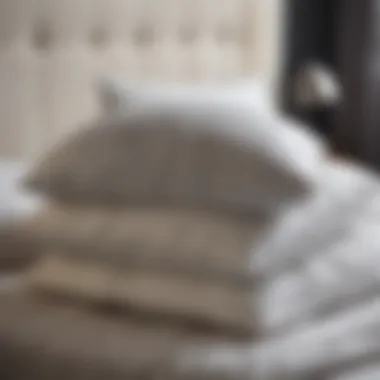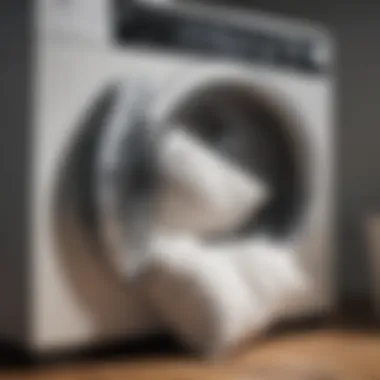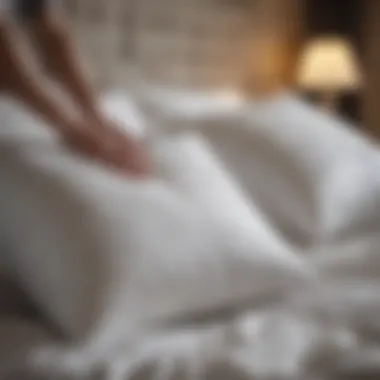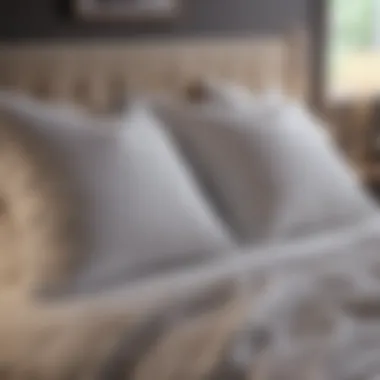A Complete Guide to Washing Your Bed Pillows Effectively


Intro
In preparing a serene sleeping environment, the often-overlooked element is washing bed pillows. How frequently do we think about the cleanliness of this pivotal component in our lives? A commitment to proper washing not only enhances hygiene standards but also boosts the longevity and comfort of our pillows. In this guide, we shall explore:
- The necessity of cleanliness in bed pillows.
- Different types of pillows and their specific care requirements.
- Effective and safe cleaning methods.
- Maintenance tips tailored for varied pillow configurations.
Understanding how to wash bed pillows goes beyond mere aesthetics. It involves recognizing their role in our overall health and fostering a restful sleep cycle.
Inspiring Homes
A welcoming living space often reflects attention to detail, especially when it comes to cleanliness in personal areas like bedrooms. Pillows with unwarranted stains or odors detract from a room's hominess. By ensuring that our pillows are clean and well maintained, we elevate the atmosphere of entire residences.
Cleaning pillows may seem straightforward, yet the method varies markedly based on the construction and materials of the pillows. From down fillings to synthetic counterparts, there is no one-size-fits-all approach. This simply illustrates how relevant the debate around bedding cleanliness is in the realm of creating inspiring homes.
The Value of Hygiene in Bedding
Prioritizing hygiene is not only a matter of preference but necessity. Pillows can harbor dust mites, allergens, and bacteria over time. Especially concerning for those susceptible to allergies, maintaining clean pillows means a significant reduction in these irritants, ultimately leading to a better sleep experience. Each wash intake promotes fresh materials that allow for optimal breathing during rest hours.
Recognizing Pillow Types
Delving deeper into the types of pillows available, we encounter:
- Memory Foam: Known for their ability to contour to the shape of the head and neck. They require more careful washing.
- Down: Plush and luxurious but need gentle handling.
- Synthetic Fibers: Generally easier to wash but still heed specific guidance.
Understanding these lead to improved self-care confidence and enhanced nightly rituals.
Cleaning Methods Explained
Addressing washing methods, homeowners often struggle with why their regular washing techniques do not seem to yield improved results.
- Machine Washing: Suitable for many types of synthetic pillows. Using a gentle cycle with specific detergents ensures preservation.
- Handwashing: A method especially applicable for memory foam pillows, ensuring that no harsh agitation alters their structure.
- Drying: Adding dryer balls helps revamp fluffiness, preserving the original texture and shape.
While some pillows declare robustness for ongoing machine washing, perhaps not all comply uniformly. Follow instruction tags to ensure compliance and preservation of each specific product description.
Important Reminder: Manufacturing tags contain critical information on maintenance requirements inexplicably tailored to types.
Maintenance Tips
In maintaining pillows, frequent inspections should occur, identifying unwarranted sagging or stains shortly. Regularly washing upon seasons or after illness can keep shared sleeping areas wholesome. Exchange pillows as you recognize extremes in wear. Maintaining fresh pillow conditions creates that inviting atmosphere at home, snug as a retreat should be.
By following these pieces of advice throughout your pillow washing journey, the notion of hygiene should feel wonderfully integrated into maintaining quality sleep. This guide offers informative steps contributing towards immaculate conservation and understood techniques for fertile resting spaces.
Understanding Your Pillows
Understanding different types of pillows as well as their unique attributes is key to the washing and maintaining process. Each pillow type has distinct material properties, which affect not only their comfort but also their cleaning needs. A thorough grasp of your pillows helps in utilizing appropriate washing methods and enhances overall hygiene in your bedding environment.
Types of Bed Pillows
Down and Feather Pillows
Down and feather pillows are filled with the soft plumage from geese or ducks. They are known for their luxurious feel and superior softness. Their primary benefit is breathability, which allows for excellent air circulation while sleeping. However, these pillows can retain moisture and get compacted over time; hence, they require specific washing methods that prevent clumping. It is essential to follow gentle washing instructions to maintain their fluffy nature.
Memory Foam Pillows
Memory foam pillows offer exceptional support, particularly for individuals with neck or back issues. They contour to the shape of the neck and shoulders, providing personalized comfort. The key feature of memory foam is its ability to adjust based on body heat and weight. However, memory foam can trap heat and moisture. Cleaning them requires careful attention to avoid damage, necessitating a less aggressive washing method, usually limited to Spot cleaning or gentle hand washing.
Latex Pillows
Latex pillows are recognized for their durability and status as hypoallergenic materials. They provide considerable support and resistance to dust mites. They mainly maintain their shape with minimal sagging. Latex pillows do not compress easily, contributing to their long-lasting use. That said, the cleaning process should be done with caution as they can be damaged by hot water and harsh detergents. It is crucial to know how to care for them properly for longevity in use.
Synthetic Pillows
Synthetic pillows, often filled with polyester or similar materials, offer a more affordable alternative to down or memory foam. They are typically lightweight and can be washed more easily than other types. The principal advantage here is their cost-effectiveness and ease of maintenance. However, they may lack the durability and comfort found in more natural materials and can flatten over time or hold take longer to dry. Knowing their specific characteristics can guide proper care methods.
Why Clean Your Pillows?


Preventing Allergens
Cleaning pillows regularly can significantly reduce allergens including dust mites, feathers, and skin flakes. When bedding pilows are not washed, these allergens can accumulate and trigger allergic reactions or respiratory issues. Regular cleaning mitigates these risks and helps promote a healthier sleeping environment.
Enhancing Sleep Quality
Hygienic bedding promotes better sleep quality. The cleanliness of pillows contributes directly to one’s comfort. Dust or dirt can lead to discomfort, affecting sleep cycles. Thus, undertaking regular washing aids in everything from physical comfort to overall relaxation.
Extending Pillow Life
Regular washing not only helps in preventing disease but also extends the life of your pillows, making a cleaner and healthier sleeping medium more durable. Proper cleaning and maintenance reflect a prolonged investment in your sleep wellness.
Preparation for Washing
Preparing to wash bed pillows is a vital step that cannot be overlooked. This process involves assessing the type of pillow you own, gathering the necessary supplies, and understanding care labels. The significance of these elements cannot be understated. Proper preparation not only ensures effective cleaning, but also protects the integrity and longevity of your pillows.
Check Care Labels
Identifying Washing Instructions
When caring for bed pillows, knowing the washing instructions is essential. Each pillow type has specific guidelines that dictate how it should be cleaned. Checking the care label provides clarity about washing temperatures and methods. This suggests which cleaning approach is receivered for your specific pillow.
Most care labels indicate whether a pillow is machine washable or requires hand washing. They may also specify if a particular detergent is necessary. Understanding these instructions can prevent damage that may arise from following the wrong cleaning procedure. Additionally, adhering umemof to these guidelines ensures cleanliness without compromising comfort.
Understanding Maintenance Symbols
Understanding maintenance symbols displayed on care labels plays a significant role in effective pillow cleaning. These symbols convey instructions succinctly. For instance, a water basin symbol indicates machine washing, while a hand symbol suggests hand washing. Recognizing these symbols can aid in interpreting the care instructions appropriately.
The key advantage of these symbols is their universal application. They eliminate language barriers, facilitating better understanding regardless of your native language. Misinterpretation of these symbols could lead to fabric damage or reduced pillow life. Thus, familiarizing yourself with maintenance symbols is a beneficial strategy in proper pillow care.
Gather Necessary Supplies
Detergent Selection
Choosing the right detergent is critical when washing pillows. Opting for a mild detergent helps maintain fabric integrity while effectively removing dirt and allergens. Natural or fragrance-free detergents are often recommended for sensitive cases. This selection directly impacts the outcome of your washing, contributing to pillow hygiene.
A characteristic feature of wise detergent selection is pH balance. Mild pH can help in cleaning without causing damage to pillow fibers. On the other hand, aggressive detergents can degrade materials or cause discoloration. Therefore, selecting an appropriate detergent aligns with the goals of maintaining both cleanliness and pillow longevity.
Washing Machine Settings
Selecting precise settings on a washing machine is significant in washing bed pillows. Utilizing a gentle cycle minimizes agitation, essential for delicate pillow types. Lowering the water temperature also helps reduce the risk of causing material shrinkage, making it a recommended choice.
A key characteristic of suitable settings is optimal spin speed. This helps in extraction of water effectively without excessive wear on pillow material. Formerly choice of cycle settings can ultimately dictate the effectiveness of the washing process while promoting the longevity of bedding products.
Drying Equipment
Using the right drying equipment is critically importnant. A suitable dryer setting, coupled with dryer balls, enhances pillow maintenance and fluffiness post-wash. This approach prevents clumping and promotes even drying—a necessity for various pillow types.
Alternatively, air drying may be embraced when dryer availability is limited. Both options are effective but differ in terms of time and ease. So selecting dryers ensures that pillows remain soft and springy, traits highly valued by all bedding enthusiasts.
Washing Methods
Washing methods play a vital role in understanding how to properly clean bed pillows. Selecting the right method can impact the lifespan and quality of your pillows. There are two main ways to wash pillows: machine washing and hand washing. Each method offers distinct advantages and considerations.
Machine Washing
Machine washing is convenient and efficient for many types of pillows.
Loading the Machine
Loading the machine properly is crucial for effective washing. Too many pillows can become overcrowded and not clean thoroughly. It is best to wash two at a time, ensuring even distribution inside the drum. This method is beneficial because it allows a balanced wash cycle, giving your pillows a better chance of coming out fresh.
One unique aspect of loading the machine is aligning the pillows to avoid snagging. Improper loading can lead to damage and wear on the pillow materials, reducing their lifespan.
Detergent Use
Choosing the right detergent is essential. A mild detergent works well for most pillow fabrics. Avoid using bleach, as it can degrade the materials and affects their integrity. This choice is beneficial not only for the cleanliness of the pillows but also for maintaining their practicality over time.


Various detergents are available. Selecting a low-sudsing type can help your machine run more efficiently. Instances of residue left in pillows can lead to allergic reactions and decreased comfort levels while sleeping.
Setting Water Temperature
Setting the correct water temperature is key in the washing process. Most pillows benefit from being washed in warm water. This helps remove dirt and allergens effectively.
Just be aware that some materials may react adversely to high temperatures, so it’s important to check the care label. A correct temperature aids in ensuring pillows remain intact and functional after the cleaning.
Hand Washing
Hand washing might be labor-intensive but can be gentler for delicate pillow types.
Preparing the Wash Basin
Preparing an appropriate wash basin is important for hand washing pillows. A clean tub or sink filled with lukewarm water with mild detergent provides a good environment for cleaning. Moreover, this method allows better control over the process.
Hand washing is a beneficial choice for preserving the pillow’s shape and structure. It minimizes agitation that a machine might impose, protecting delicate fillings such as down or feathers from damage.
Gently Agitating the Pillow
Gently agitating the pillow encourages cleaning without excessive strain to the filling. It is also significant in ensuring that all areas receive exposure to detergent and water. When monitoring how you agitate the pillow, you help uphold the durability of the materials.
This method provides an effective wash while preventing wear that often naturally occurs with machine washing assistance. Also, by being present during this stage of the wash, it allows for adjustment based on threat level perceived on the pillow, should there be any stains or spots present.
Rinsing Techniques
Rinsing techniques used in hand washing must focus on removing all detergent residuals thoroughly. It’s crucial to rinse repeatedly until the water runs clear. Ignoring this detail may lead to skin irritation for some users.
This step proves beneficial for preventing any build-up on the pillows that can attract dust mites. Carefully rinsing contributes to overall hygiene, making your sleeping environment healthier.
Overall, each washing technique presents unique advantages. consider your pillow materials when choosing a method.
Drying Processes
Drying bed pillows is a crucial step after washing. Proper drying ensures that pillows return to their original shape and function. It prevents the buildup of mildew and bacteria, which can lead to health issues. This section explores methods for drying pillows, outlining their benefits, considerations, and best practices to achieve a clean and fresh outcome.
Using a Dryer
Appropriate Drying Settings
Choosing the right drying settings is essential when drying pillows in a dryer. A low or medium heat settings is usually ideal, as high heat can damage sensitive materials, especially for down or memory foam pillows. Air-dry options can reduce the risk of over-drying while still providing effective results.
This approach contributes significantly to maintaining the shape and integrity of the pillows. Using the proper settings also helps to evenly distribute the heat, ensuring thorough drying without causing clumping or damage.
Important: Always refer to the care label for guidance.
One unique aspect of appropriate drying settings is consistency. Maintaining a controlled temperature during the drying process helps prevent excessive wear and allows for rejuvenation of pillow materials.
Using Dryer Balls for Fluffing
Incorporating dryer balls into the drying process can greatly enhance results. Dryer balls work by agitating the laundry, creating space between items. This avoids clumping and fluff the pillows evenly as they tumble. Natural wool dryer balls are preferred for their effectiveness and lack of synthetic materials.
The unique feature of using dryer balls is the addition of air flow they facilitate within the dryer. This ensures that the pillows dry thoroughly and maintain volume. A downside to keeping stout woolers can be higher upfront costs but the long-term benefits justify such an investment.
Air Drying
Best Practices for Sunlight Exposure
Air drying can be an effective method, especially if you want to avoid using electronic appliances. Sunlight exposure can naturally bleach stains and help disinfect pillows with ultraviolet rays. Not sun drying should coincide with your locality’s weather patterns- a cleaned pillow can take time, even with good conditions.
A crucial tip to note is positioning the pillows. Place them in the direct line of sunlight for optimal results, flipping them over from time to time to ensure even drying while also permitting the filler materials to breathe free of dampness.
Choosing a Good Location
The location where pillows air out can impact drying time and effectiveness. Avoiding damp or confined spaces reduces the risk of mold growth during the drying period. A well-ventilated area with good air circulation, especially outside, provides a vast benefit.


Near windows and doors may serve as good options. Furthermore, setting the pillows on a clean and breathable surface will also prevent water pooling beneath, impacting the intact cleanliness gained from washing. Balancing convenience with effective moisture reduction is key here, ensuring you have fresh and cleaned linens to enjoy.
Post-Washing Care
Post-washing care is a critical phase when it comes to maintaining the integrity and quality of your bed pillows. After a good wash, pillows need proper treatment to ensure they remain comfy, clean, and effective. Care after washing impacts not only the appearance of the pillows but also their longevity and hygiene.
Fluffing Pillows
The Importance of Fluffing
Fluffing pillows isn’t just for show; it serves an important practical purpose. When pillows are washed, their fibers can become flattened and misshapen. Fluffing helps them regain their loft and shape. This action promotes their main function: providing essential support for the neck and head during sleep. Well-fluffed pillows contribute to better sleep quality and reduce the chance of neck or back pain.
A main characteristic of fluffing is the redistributing of fill inside the pillow. This is beneficial because it also prevents the fill from clumping together, which can happen after washing. Overall, fluffing post-wash ensures that the pillow stays functional and prolongs its lifespan.
Methods for Effective Fluffing
Effective fluffing techniques are key for achieving the best results. The most popular method involves taking the pillows and patting them down gently. Using your hands, compress the pillow for a short time and then let go. This motion revitalizes the filling, resulting in a more refreshed appearance. Another option is to place the pillows in the dryer on a low heat setting* along with dryer balls. The gentle heat warms both the outer and inner surfaces, allowing the pillow filling to relax and expand.
It is also advisable to do some gentle punching instead of aggressive shaking. This approach helps to restore shape and fluff without putting damage to the structure of your pillows.
Storing Pillows
Choosing the Right Storage Environment
Storing pillows correctly is very important to maintain their quality. When choosing the storage environment, away from direct sunlight is best, as UV rays can degrade the fabric and fill. Additionally, a dry place prevents any mold and mildew formation, preserving hygiene.
A climate-controlled area is ideal for Pillow storages, where temperature fluctuations are minimized. Using breathable cotton storage bags can also help shield the pillows from dust while allowing them to maintain ventilation.
Avoiding Compression Damage
Compression can significantly impede the effectiveness of pillows. To avoid this, it is crucial not to stack heavy objects on top of stored pillows. It’s wise to simply store them in a specific area with space around them, so they retain their shape even while not in use. When not in bed, pillows should be placed vertically rather than horizontally, as this helps keep their fluffiness intact.
Both choosing the right environment and avoiding compression damage will help keep your pillows clean and offer great service when needed again.
Proper care in post washing significantly increases the lifespan and comfort of your pillows.
Additional Maintenance Tips
Maintaining bed pillows involves more than just washing. Attention to the small details can have a significant impact on both hygiene and comfort. Additional maintenance tips provide a framework that can help prolong the life of your pillows while keeping them fresh and clean. Adopting these practices offers practical benefits like reducing allergens and improving sleep quality.
Frequency of Washing
Guidelines for Different Pillow Types
The frequency of washing pillows varies depending on their material. It's essential first to recognize the specific quilting of the pillow to apply the appropriate technique. Down and feather pillows often require washing every few months due to their ability to retain allergens. Conversely, synthetic pillows could be more maintainable, sometimes needing only biannual washing.
Understanding these guidelines ensures that the distinct characteristics of your pillows are properly considered. For example, memory foam pillows can be ruined if washed in water, signaling the need to follow manufacturer instructions carefully. Limiting exposure to moisture helps maintain their supportive properties, ensuring ongoing comfort and effectiveness.
Incorporating a sensible washing routine according to the type also prevents quicker deterioration.
Identifying Signs of Wear
Identifying signs of wear and tear is vital. Each pillow has a lifespan dependent on its material and frequency of use. Recognizing signs such as lumps, discoloration, or foul odors can prompt earlier replacement or action. This awareness contributes significantly to maintaining not just comfort but also the functional capacity of your bedding.
A noticeable sagging bodes further discussions about efficacy. Thus, frequent room assessments help maintaining your optimal sleeping arrangement. Once wear is recognized, it can assist in pinpointing when replacements should be made.
Protective Measures
Using Pillow Protectors
Pillow protectors serve as an effective safeguarding measure for your bedding. They act as the first line of defense against dust mites, stains, and moisture. Selecting an appropriate cover helps add another layer that can significantly contribute to prolonged pillow life, enhancing both hygiene and sleep quality.
The right cover will not only prolong the functionality but will also serve the purpose of preventing allergens from settling deep within, attributing to an overall improved sleeping environment. It also eases cleaning and keeps the pillows looking new for an extended period.
Avoiding Common Stains
Preventing stains is crucial, especially considering the sensitivity of some pillow fabrics. Food locations, personal care products, and skincare routines can often lead to unexpected stains that tarnish pillow fabric. Incorporating good habits can contribute greatly to avoiding degeneration. Regularly cleaning cases and following precautionary measures to mitigate contact from various episodes makes a considerable difference.
Focusing on protective measures does enhance mattress quality by keeping surfaces knit tight against damage. Ultimately, avoiding unnecessary food usage on beds provides greater long-term results.—
In summary, these additional maintenance tips are essential in fostering a clean, relaxed sleeping environment while extending the usable life of your pillows. Regular care and protective proceedings are not just best practices; they unfold a deep awareness of the integrality needed for plush sleep.
"Regular care and awareness can prolong the lifespan of your bed pillows significantly, paying dividends down the road in comfort and hygiene."

